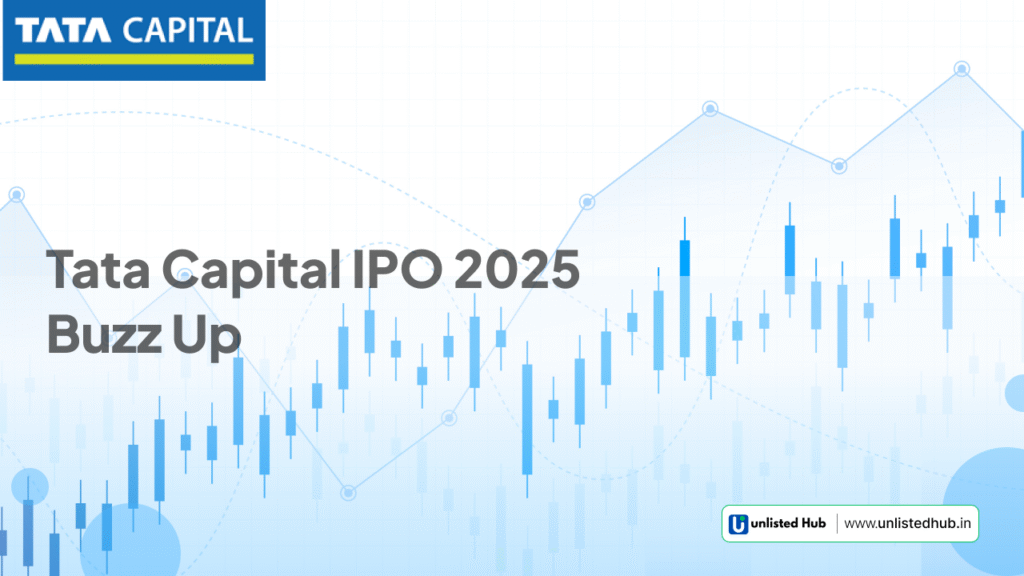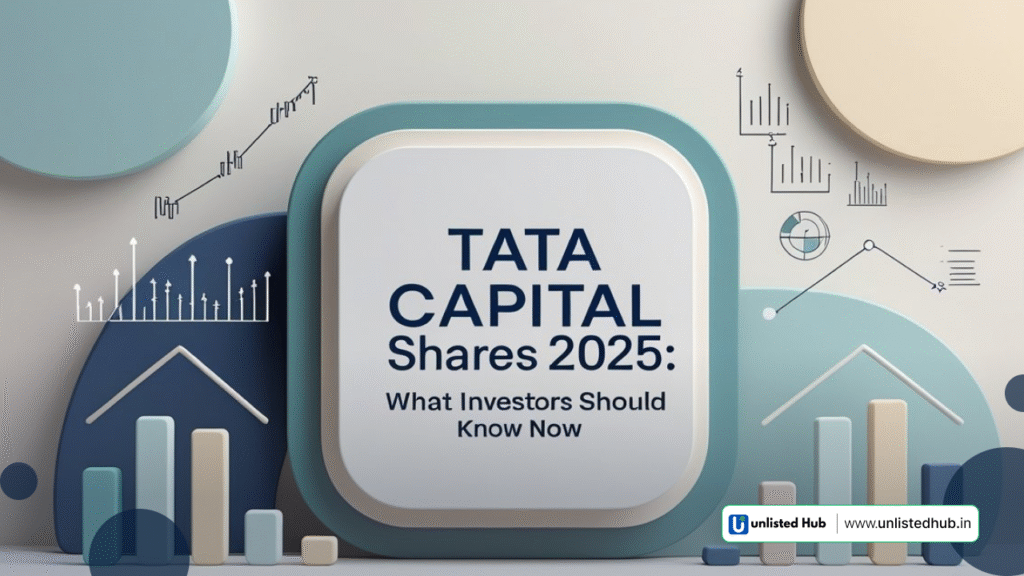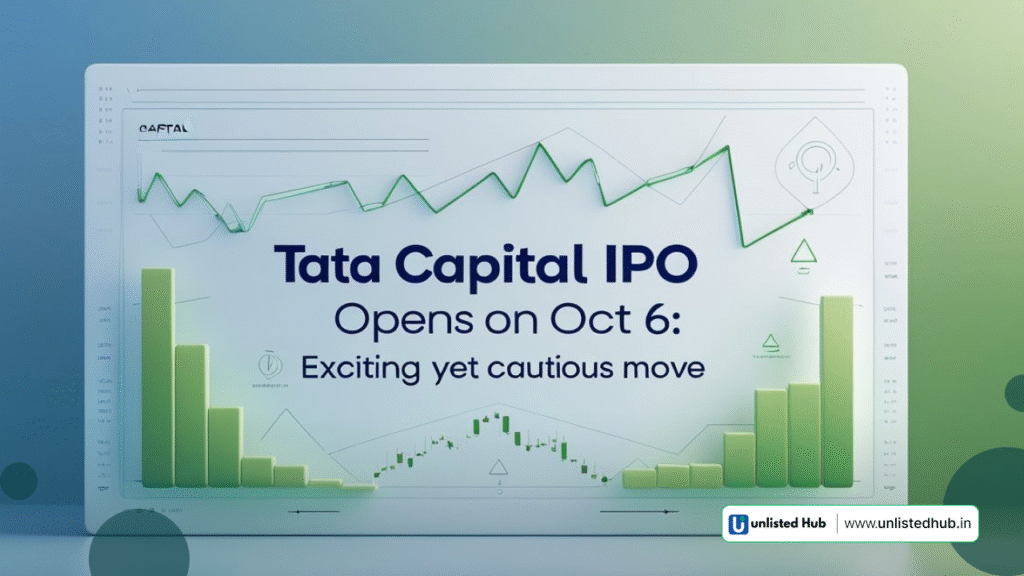A. Breaking News: Tata Capital Files DRHP for Blockbuster IPO
Tata Capital, the financial services arm of Tata Sons, has officially filed its Draft Red Herring Prospectus (DRHP) with SEBI for a highly anticipated IPO expected in 2025. According to recent regulatory disclosures and insider reports, the IPO aims to raise around ₹17,200 crore, making it one of the largest financial services IPOs of the year.
The issue will include a mix of fresh equity issuance and an Offer for Sale (OFS), with Tata Sons (holding ~93%) likely to divest a small portion of its stake. This marks a strategic move in the Tata Group’s ongoing value-unlocking efforts across its unlisted business verticals.
Why This Matters
-
Rides the NBFC Boom: Launching into a rapidly expanding Indian credit market
-
Tata Group Backing: Deepens investor trust and ensures institutional participation
-
Capital Boost: Fresh funds to accelerate growth in retail lending, digital infrastructure, and ESG finance
-
Valuation Clarity: Enables price discovery for one of India’s most sought-after unlisted shares
Product & Platform Highlights
-
25M+ customers across retail, SME, infrastructure, and housing finance
-
AI-powered credit models and 100% paperless onboarding for personal and consumer loans
-
Tata Cleantech Capital: India’s first private NBFC focused on green and sustainable finance
-
Synergy with Tata Neu app enhances cross-sell potential and customer loyalty
Note: Market sentiment indicates that the Tata Capital IPO may emerge as one of the biggest pre-IPO wealth-creation opportunities of 2025.
B. Government Backing & Policy Tailwinds
While Tata Capital isn’t directly funded by the government, its operations align closely with India’s financial inclusion and infrastructure expansion goals—a space where policy momentum is strong.
Policy Support & Sectoral Incentives
- RBI’s regulatory framework for top-tier NBFCs supports credit expansion with guardrails
- Credit Guarantee Schemes for MSMEs boost Tata Capital’s small business lending
- Digital India & Financial Literacy Drives open new consumer bases in Tier 2/3 markets
- Housing for All (PMAY) aligns with Tata Housing Finance’s affordable housing initiatives
Future Policy Outlook
- Expected relaxation in fintech regulations and continued push for green financing
- Union Budget focus on capex, housing, and clean energy finance benefits its infrastructure and ESG portfolios
- Bharat-centric growth, aided by state and central schemes, drives deeper credit penetration
C. Company Overview
Established in 2007, Tata Capital Limited is a core subsidiary of Tata Sons and operates as one of India’s largest and most diversified NBFCs. Its offerings span personal loans, SME loans, infrastructure finance, housing finance, wealth management, and green financing.
With over 25 million customers and a strong digital infrastructure, Tata Capital is known for its customer-centric approach and prudent risk management practices.
Unlisted Share Highlights (As of 2025)
- Estimated Market Cap (post-listing expectations): ₹1.48 lakh crore (Tata Group’s target valuation)
- Last Traded Price: Rights issue at ₹343 per share (July 2025), unlisted market previously at ₹600–₹650
- PAT FY24: ₹3,327 crore
- ROE: 13.5%
- Loan Book: ₹1.39 lakh crore
- Gross NPA: 1.71%
- Book Value/Share: ₹66.43
Comparable listed peers include Bajaj Finance, Cholamandalam Finance, and L&T Finance, but Tata Capital offers a unique mix of brand equity, digital scale, and ESG-focused lending.
Group Synergies: As part of Tata Group, the company benefits from cross-sell opportunities with Tata Motors, Tata Neu, Tata Housing, and TCS-powered digital infrastructure.
D. Business Model & Revenue Streams
Tata Capital operates a diversified, multi-vertical business model, serving both retail and institutional segments through a technology-driven and customer-first approach.
Primary Business Lines
-
Retail Lending Segments: Personal Loans, Two-Wheeler Loans, Consumer Durable Financing
-
SME Lending: Working capital, equipment finance, business expansion loans
-
Infrastructure Finance: Focused on renewable energy, transport, and logistics
-
Housing Finance: Affordable and premium home loan offerings
-
Wealth Management & Distribution: Mutual funds, insurance, portfolio advisory
Revenue Segmentation (Approximate)
-
Retail Lending – 45%
-
SME & Corporate Lending – 30%
-
Housing Finance – 15%
-
Wealth & Advisory Services – 10%
Key Business Characteristics
-
B2C-dominant model with a strong foothold in retail lending
-
Pan-India presence with targeted growth in Tier 2 & Tier 3 cities
-
Stable, recurring revenues from long-tenure housing and infra loans
-
Export Exposure: Minimal to none – business is primarily domestic
-
Client Profile: Urban salaried professionals, MSMEs, infrastructure developers, and real estate players
E. Financial Performance Snapshot (FY22–FY24)
Tata Capital’s financials reflect consistent growth, prudent lending, and superior margins—a testament to the group’s long-term business approach.
| Metric | FY22 | FY23 | FY24 (Est.) |
|---|---|---|---|
| Total Revenue | ₹10,440 Cr | ₹13,020 Cr | ₹16,200 Cr |
| PAT | ₹1,970 Cr | ₹2,450 Cr | ₹3,327 Cr |
| Gross NPA | — | — | 1.71% |
| Book Value/Share | — | — | ₹66.43 |
| ROE | — | — | 13.5% |
Key Ratios & Insights
- Debt-to-Equity: ~4.1x – within regulatory bounds
- ROCE (FY24): 13.5% | Interest Coverage: 2.8x
- CAGR in PAT (FY22–FY24): ~26%
- Growth Sustainability: NIMs stable; risk-adjusted returns improving
F. Key Risks & Challenges
While Tata Capital boasts solid financials and strong brand backing, it still faces several important business risks that investors should consider:
Top Risk Factors
-
Asset Quality Pressure
Rising stress in unsecured retail and SME lending, with Gross NPA (GNPA) reaching 1.71% in FY24 -
Regulatory Shifts
RBI’s tightening norms for NBFCs could restrict growth flexibility and increase compliance costs -
High Leverage
A debt-heavy balance sheet, particularly in infrastructure finance, may raise cost of capital and affect margins -
Rising Competition
Emerging fintech lenders and digital NBFCs are compressing interest spreads and pricing power in key segments
Mitigation Measures
-
AI-Driven Risk Management
Use of AI-based credit models, real-time tracking, and tighter approval protocols help minimize loan defaults -
Diversified Loan Book
Exposure across multiple lending verticals (retail, SME, infra, housing) reduces concentration risk -
Strong Liquidity & Ratings
Backing from Tata Sons ensures access to capital, high credit ratings, and lender confidence -
Operational Efficiency
Focus on cost optimization, digital agility, and prudent asset-liability management (ALM) strengthens financial resilience
G. Growth Drivers & Investment Rationale
Tata Capital is uniquely positioned to benefit from India’s accelerating credit demand, growing digital lending infrastructure, and the formalization of financial services across urban and rural markets.
Macro-Level Catalysts
-
Digital Lending Surge
Rapid adoption of instant, app-based credit post-pandemic is driving NBFC lending volumes -
Affordable Housing Momentum
Aligned with central housing policies like PMAY, boosting home loan demand -
Rise of ESG Investments
Growth in green financing through Tata Cleantech Capital, supporting sustainable infrastructure projects -
Infrastructure Boom
Government’s ₹10 lakh crore public infra spending creates long-term lending opportunities in logistics, power, and mobility
Company-Specific Growth Triggers
-
Tech-Driven Innovation
Heavy investments in AI, automation, and digital onboarding to enhance underwriting and operational efficiency -
Ecosystem Leverage
Low-cost customer acquisition via Tata Group’s integrated platforms (Tata Neu, Tata Motors, Tata Retail) -
Balance Sheet Strengthening via IPO
The IPO proceeds will reinforce the capital adequacy ratio and improve lending capacity -
Deeper Market Reach
Targeted expansion into Tier 3 and Tier 4 cities, enabling stronger credit penetration in underserved segments -
Attractive Valuation Entry Point
Tata Capital’s unlisted valuation is aligned with industry benchmarks, offering a favorable multiple relative to peers like Bajaj Finance and Cholamandalam Finance
Final Verdict: Is Tata Capital the Next Multi-Bagger?
Tata Capital’s blend of operational excellence, diversified lending, digital integration, and group backing makes it one of the most promising IPO candidates in 2025. Its pre-IPO financials reflect disciplined growth and high-margin sustainability. With a strong presence in core sectors of the Indian economy and alignment with future macro trends, Tata Capital unlisted shares offer rare access to a business ready for public market leadership.
Bottom Line:
For long-term investors seeking exposure to India’s expanding credit landscape, Tata Capital’s IPO offers an early-stage opportunity with promising upside and relatively lower competition.
FAQs
1. What is the expected size and timeline of the Tata Capital IPO?
– The Tata Capital IPO aims to raise ₹15,000–₹17,200 crore and is expected to launch by September 2025, meeting RBI’s listing timeline for top-tier NBFCs.
2. Why is Tata Capital going public now?
– The IPO serves both as a strategic growth initiative and a regulatory mandate under RBI’s framework, which requires upper-layer NBFCs like Tata Capital to list by September 2025.
3. What will be the structure of the Tata Capital IPO?
– The IPO will consist of a fresh issue of shares to raise new capital and an offer for sale (OFS) by existing shareholders, including Tata Sons.
4. What are the objectives of the Tata Capital IPO?
– Funds raised will be used to strengthen Tata Capital’s capital base, support business expansion, enhance lending capacity, and comply with regulatory requirements for NBFCs.
5. How will the Tata Capital IPO impact Tata Group companies and shareholders?
– A successful listing is expected to boost the valuation of Tata Sons and its subsidiaries. It may also positively influence the share prices of Tata Group companies like Tata Investment Corporation and Tata Motors.
6. What is the current financial health and market position of Tata Capital?
– As of March 2024, Tata Capital had ₹1.76 lakh crore in assets and ₹1.57 lakh crore in loans, ranking 7th among NBFCs by loan size, with strong growth and digital focus.
7. How can investors apply for the Tata Capital IPO, and what is the minimum lot size?
– The Tata Capital IPO will be listed on BSE and NSE. Details like price band, lot size, and application process will be announced in the Red Herring Prospectus closer to the launch.
8. What are the key risks and challenges associated with investing in Tata Capital’s IPO?
– Risks include exposure to macroeconomic fluctuations, borrower defaults, regulatory changes, and rising competition from fintech and digital lenders. Investors should review these risks before applying.
Disclaimer: This article is for informational purposes only. Please consult a financial advisor before making any investment decisions.





